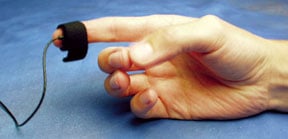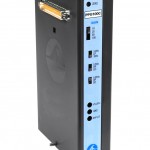The ergonomic housing design improves contact with the subject and helps reduce motion artifact. The TSD200 is primarily designed for finger attachment, but can be taped to other body locations. The TSD200 comes with a shielded 3-meter cable.
For TSD200C: When the PPG transducer is clipped to the earlobe, in proximity to capillaries, the reflectance of the infrared light from the emitter to the detector will change in accordance to capillary blood volume. The photodetector operates via incident photons, from an IR transmitter, impacting an IR detector. The incident photons result in a proportional passage of electrons in the detector. The IR detector operates like a photon-controlled current source. The transducer incorporates an appropriate clipping range, with linearity insured for arbitrarily low levels of reflected light. For the expected magnitude of incident infrared light, the photodetector operates in a linear fashion. We have not encountered situations where the detector is operating non-linearly (near saturation).
See also…
- Wireless Pulse – BioNomadix PPG and EDA Amplifier – BN-PPGED
- Telemetry System equivalent—SS4A
- BIOPAC MRI Guidelines





Stay Connected